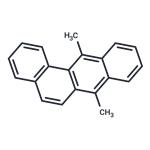DBA is a greenish-yellow solid. Polynucleararomatic hydrocarbons (PAHs) are compounds containingmultiple benzene rings and are also called polycyclic aromatic hydrocarbons. Molecular weight= 256.36; Freezing/Melting point= 122℃. Insoluble in water
7,12-Dimethylbenz[a]anthracene was used:
- to study the effects of Cimicifuga racemosa (CR) extract on the growth of mammary tumor induced by 7,12-Dimethylbenz[a]anthracene
- in the study to compare the anti-carcinogenic properties of four red wine polyphenols as an initiator to cause skin cancer in CD-1 mouse model
- to induce epithelial carcinogenicity in order to study the apoptotic, proliferating and p12doc-1 profiles of normal, hyperplastic, dysplastic and malignant oral epithelium in the cheek pouch of the Syrian hamster
- to cause mammary tumors to examine the causes and prevention of triacylglycerol accumulation in rat liver due to tamoxifen
A highly potent carcinogen that is activated by microsomal enzymes to a diol epoxide metabolite that binds covalently to DNA in mammalian cells, leading ultimately to tumor induction
ChEBI: A tetraphene having methyl substituents at the 7- and 12-positions. It is a potent carcinogen and is present in tobacco smoke.
Yellow to greenish-yellow crystals or a yellow solid. Odorless. Maximum fluorescence at 440 nm. Bluish-violet fluorescence in UV light.
7,12-DIMETHYLBENZ[A]ANTHRACENE is incompatible with strong oxidizing agents .
7,12-DIMETHYLBENZ[A]ANTHRACENE is combustible.
7,12-Dimethylbenz[a]anthracene has been found to be cytotoxic in nature, having carcinogenic properties. It also shows selective necrosis and hemorrhaging in the adrenal gland along with an inhibitory effect on plasma alkaline phosphatase levels. Its damaging effects are due to its ability to form charge transfer complexes by donating electrons to appropriate electron acceptors.
Suspected carcinogen
with experimental carcinogenic,
neoplastigenic, tumorigenic, and teratogenic
data. A transplacental carcinogen. Poison by
ingestion, intravenous, subcutaneous,
intraperitoneal, and intratracheal routes.
Other experimental reproductive effects.
Human mutation data reported. A skin
irritant. When heated to decomposition it
emits acrid smoke and irritating fumes.
If this chemical gets into the eyes, remove anycontact lenses at once and irrigate immediately for at least15 min, occasionally lifting upper and lower lids. If thischemical contacts the skin, remove contaminated clothingand wash immediately with soap and water. If this chemicalhas been inhaled, remove from exposure, begin rescuebreathing (using universal precautions, including resuscitation mask) if breathing has stopped and CPR if heart actionhas stopped. Transfer promptly to a medical facility
Color Code—Blue: Health Hazard/Poison: Storein a secure poison location. Prior to working with DBA youshould be trained on its proper handling and storage. Storein tightly closed containers in a cool, well-ventilated areaaway from oxidizers. A regulated, marked area should beestablished where this chemical is handled, used, or storedin compliance with OSHA Standard 1910.1045.
The name of this material is not in the DOT listof materials for label and packaging standards. However,based on regulations, it may be classified as anEnvironmentally hazardous substances, solid, n.o.s. Thischemical requires a shipping label of “CLASS 9.” It falls inHazard Class 9 and Packing Group III.[20,21
Purify DMBA by chromatography on alumina/toluene or *benzene. Crystallise it from acetone/EtOH. [Beilstein 5 IV 2587.]
Contact can irritate and burn theskin and eyes. Irritates the respiratory tract. High exposuremay damage the blood cells, causing anemia
The IRSL and SRSL were derived from the inhalation unit risk (IUR) factor for B(a)P of 1.76E-3 per μg/m3 .
![7,12-DIMETHYLBENZ[A]ANTHRACENE Structure](/CAS/GIF/57-97-6.gif)

![7,12-DIMETHYLBENZ[A]ANTHRACENE pictures](/ProductImageEN/2021-12/Small/f9ee8ff5-e927-4883-9000-57fc2a5211c8.png)
![7,12-DIMETHYLBENZ[A]ANTHRACENE pictures](https://img.chemicalbook.com/ProductImageEN/2020-2/Small/2c229b66-15e6-4d27-8f91-9c0d6513fcb8.jpg)